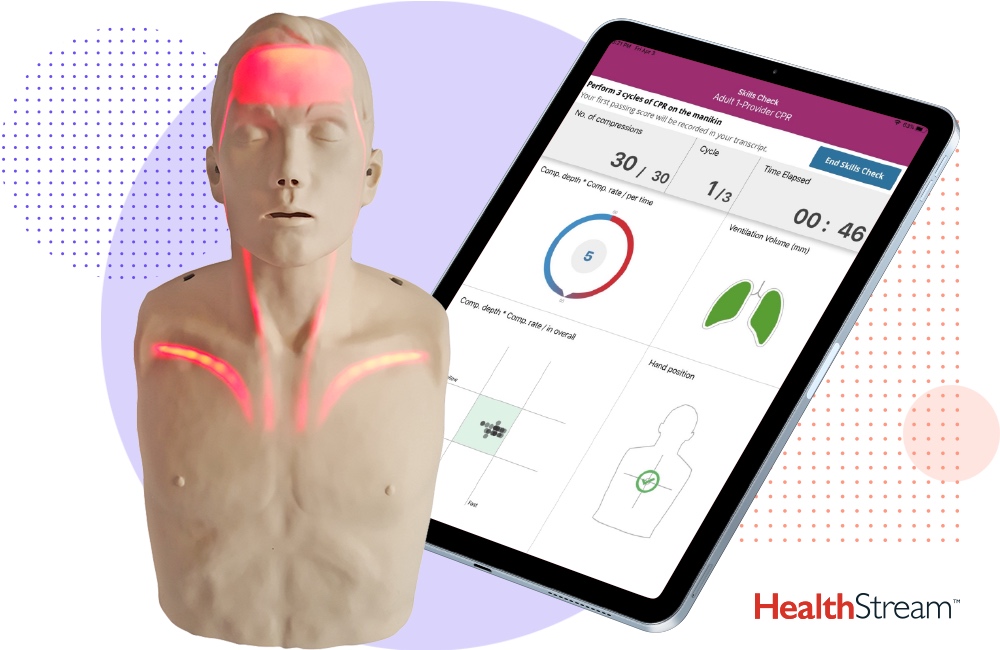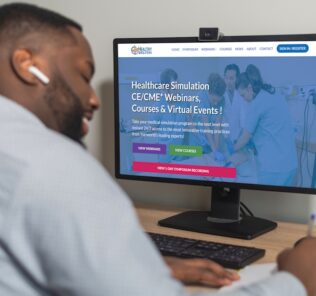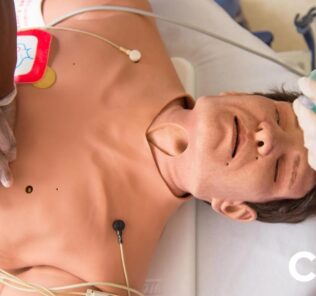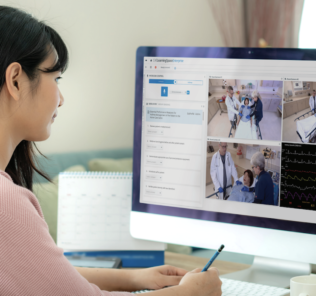HealthStream Advances Resuscitation Proficiencies with Innovative, Manikin Technology
Healthcare simulation technology has helped to advance clinical education by providing solutions through which learners are able to practice and hone their skills. One company offering such solutions, HealthStream, is committed to helping organizations prioritize a culture of quality and safety through proven solutions that focus specifically on changing healthcare staff behavior. One way the company works to achieve this goal is through the development of manikin technology. This article details the benefits of HealthStream manikins, and explains how they help promote mastery.
In this HealthStream video, Allison Sawyers, a clinical simulation solution executive with HealthStream, demonstrates what makes the BraydenPro Manikin one of the most technologically advanced CPR manikins available today. Simultaneously, HeathStream’s Resuscitation Team Lead, James Wilber, explains the steps used to operate the manikins. First, the manikins are run by batteries or an AC adapter to the wall. They then connect to an iPad via Bluetooth, eliminating the need for cables or cords, while keeping the assessment area safe and uncluttered.
The Brayden Pro hStream certified adult and infant digitally measure all core metrics and real-time performance of high-quality CPR, this includes compression depth, recoil, hand placement, and rate through sensors in the torso of the manikin. Sensors in the airway digitally measure the volume of air being pushed in during ventilations, as well as ventilation speed. The data is transferred to the iPad and Resuscitation Skills app via Bluetooth, which provides visual feedback instantaneously to the student as they are performing CPR.
Sponsored Content:
Visual feedback is what is used with many monitors to provide coaching on CPR and debriefing following the exercise. These visual indicators allow the student to self-correct errors on the very next compression or ventilation. As the data is measured digitally, it will provide unbiased, error-free feedback every time.
To use the Brayden Pro manikin, learners should simply power on the manikin, log into the iPad app, and connect the manikin to the app with a HealthStream ID. Once logged into an individual account on the app, press the connect button and select the BraydenPro manikin. Next, the user will navigate through a brief setup, and when prompted they should click “adult compressions.” This is the ideal set-up for using the Brayden Pro manikin.
During the compression assessment, the app provides instant feedback. When finished, the app will provide a score card noting how the learner performed during the assessment, as well as giving coaching to correct any imperfections pointed out during CPR. If the learner fails the first round of CPR, the learner can click the try again button to retake the assessment. This can be done as many times as necessary until a passing grade is achieved.
“As you can see the new advances in manikin technology allow students to be self-paced and self-taught and self-directed and only requires the student, manikin, and iPad to complete their CPR assessment. Combined with the unbiased digitally measuring and instant feedback you are getting the highest standard of education across the board,” said Sawyers.
Sponsored Content:
Supportive BLS Simulation Training Research
Additionally, the following research, titled “Certified Basic Life Support Instructors Identify Improper Cardiopulmonary Resuscitation Skills Poorly,” overviews instructor skill assessments versus manikin data, with the findings that the manikins provide more quality, accurate training for resuscitation. They are able to be a lot more accurate given sensors compared to the human eye.
Through the data collection of BLS courses for medical students at Aarhus University, Aarhus, Denmark, two certified BLS instructors were able to evaluate learners with a cardiac arrest test scenario. This is where learners demonstrated CPR on a resuscitation manikin for 3.5 minutes. The Instructors’ assessments were then compared with manikin data as reference for correct performance.
During this study, 90 CPR assessments were performed by 16 instructor pairs. According to the research, the first three CPR cycles were analyzed. Correct chest compressions were defined as 2 or more of 3 CPR cycles with 30 ± 2 chest compressions, 50 to 60 mm depth, and 100 to 120 min−1 rate. Correct rescue breaths were defined as 50% or more efficient breaths with visible, but not excessive manikin chest inflation (for instructors) or 500 to 600mL air (manikin data).
Ultimately, the research showed that certified BLS instructors assess CPR skills poorly, with improper chest compression depth and rescue breaths were not identified. Both shallow and Female learners more often performed shallow chest compressions, whereas male learners often performed chest compressions that were too deep. Moreover, instructors generally overestimated learners’ rescue breathing performances.
“This overconfidence in skills and poor skills being reinforced during training has the potential of leading to negative skills transfer when performing CPR on a patient” states Bo Latham National Registered Emergency Medical Technician (NREMT), Certified Simulation Operations Specialist (CHSOS), and Sr. Product Manager for Resuscitation at HealthStream. “We know that when CPR is performed at guidelines it is inherently inefficient when compared to normal and healthy perfusion. It is critically important to get these skills right to reduce cerebral ischemia and hypoxia”
More About HealthStream
HealthStream is an information technology and services company that is dedicated to improving patient outcomes through the development of healthcare organizations’ greatest asset: their people. The company’s unified suite of solutions is contracted by, collectively, approximately 4.8 million healthcare employees in the U.S. for workforce development, training and learning management, talent management, credentialing, privileges, provider enrollment, performance assessment, and managing healthcare simulation-based education programs.
These solutions help develop and empower people to deliver the highest quality of care. The company understands clients’ need to maximize resources in an increasingly complex healthcare environment. HealthStream has worked side-by-side with 4,000+ healthcare organizations for over 30 years to cultivate a more competent and engaged workforce. Founded in 1990, the company is based in Nashville, Tennessee. HealthStream has additional offices in Brentwood, Tennessee; Jericho, New York; Boulder, Colorado; San Diego, California; and Chicago, Illinois.
Since its foundation, HealthStream has received 15 Brandon Hall Excellence in Technology Awards for 2020. These honors demonstrate HealthStream’s ongoing commitment to technological innovation in healthcare workforce development, as well as the ultimate goal of improving healthcare outcomes. The Smithsonian also presented HealthStream with the Computerworld Smithsonian Medallion in recognition of its achievement in its innovative use of technology to empower and advance society.
Learn More About HealthStream
Lance Baily, BA, EMT-B, is the Founder / CEO of HealthySimulation.com, which he started in 2010 while serving as the Director of the Nevada System of Higher Education’s Clinical Simulation Center of Las Vegas. Lance also founded SimGHOSTS.org, the world’s only non-profit organization dedicated to supporting professionals operating healthcare simulation technologies. His co-edited Book: “Comprehensive Healthcare Simulation: Operations, Technology, and Innovative Practice” is cited as a key source for professional certification in the industry. Lance’s background also includes serving as a Simulation Technology Specialist for the LA Community College District, EMS fire fighting, Hollywood movie production, rescue diving, and global travel. He and his wife live with their two brilliant daughters and one crazy dachshund in Las Vegas, Nevada.
Sponsored Content:






















